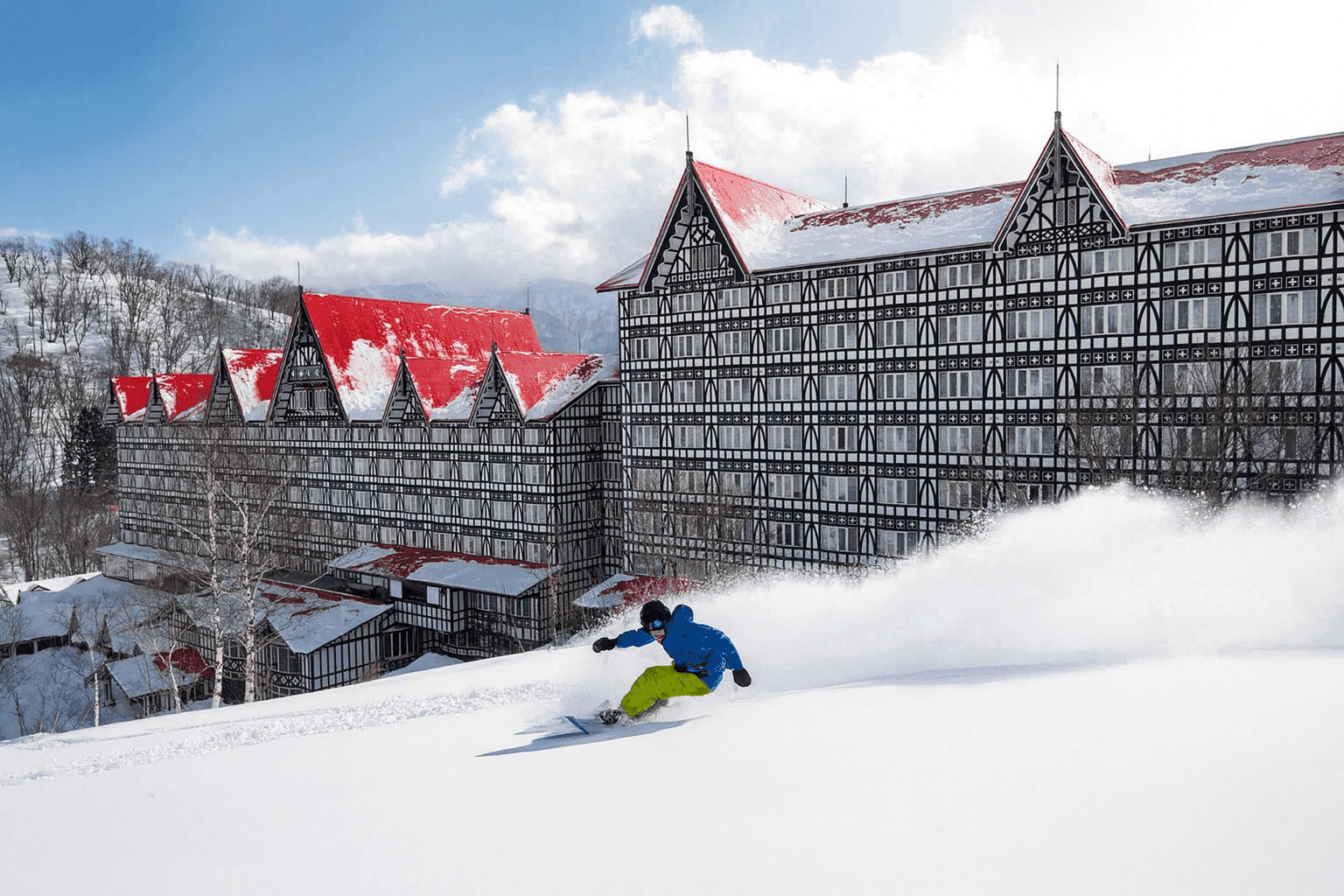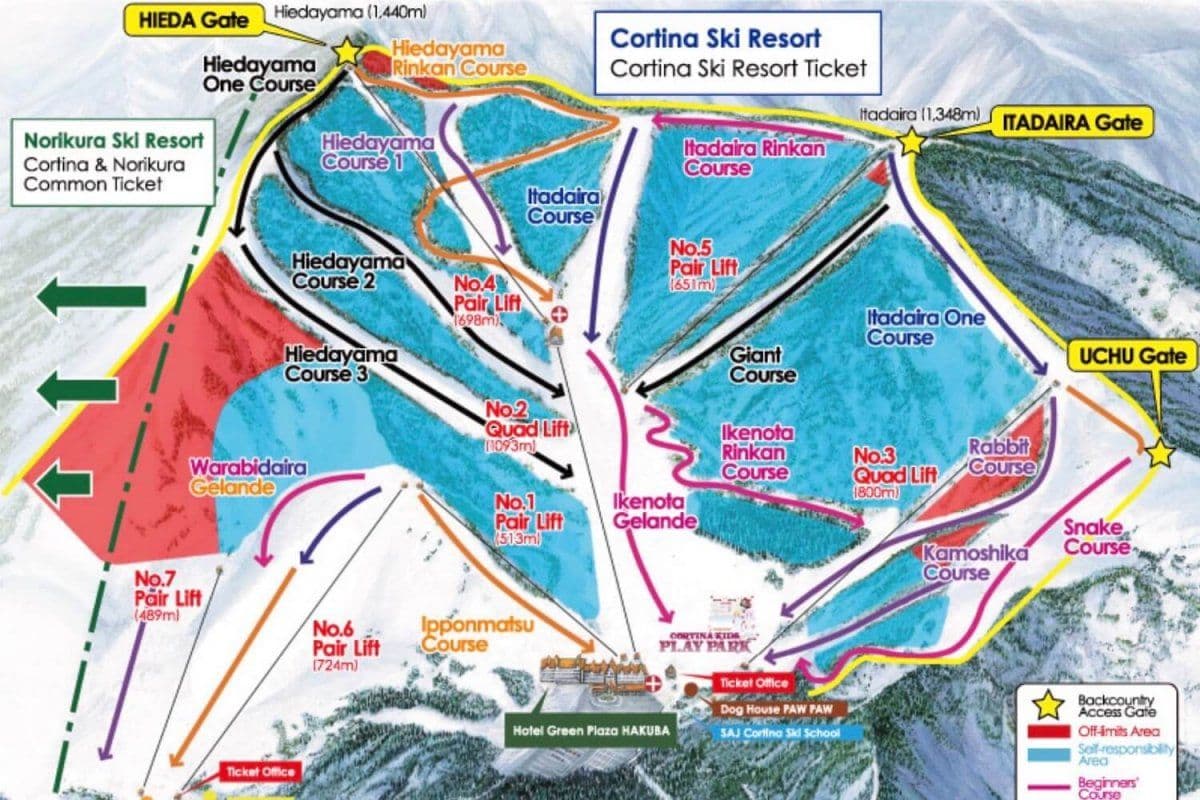Cortina
The Steep & Deep of Hakuba

コルチナ
Quiet Bowl, Epic Snow, True Hakuba Feel
Cortina sits at the very northern end of the Hakuba Valley, backed into a natural amphitheatre of steep bowls and tree-lined ridges. From the moment you see the distinctive red-roofed Hotel Green Plaza Hakuba rising at the base, you know you’re in a different kind of resort. There’s no sprawling high street or busy base plaza here—just a tight-knit cluster of buildings and a ski hill that looms high and inviting right out the back door. The vibe is low-key, but the snow totals are anything but. Storms slam into the surrounding peaks, funneling moisture-rich clouds into this corner of the valley and dropping knee-to-waist-deep powder with clockwork regularity.
For many years, Cortina was a whispered secret — known mostly to those who could be bothered to drive or bus all the way up from central Hakuba. That’s changed. The freeride-friendly tree policy and reputation for big dumps have put it firmly on the map for international riders. On a bluebird weekend after a storm, you’ll see vans from every corner of the valley parked here before first light. But midweek, or on days when the weather’s foul, it still feels like the semi-hidden powder trap it’s always been.
The terrain here is split between long, forgiving groomers that funnel beginners and families right to the base, and a network of steeper, wilder lines that fan out under and between the lifts. From the upper quads, it’s a short traverse to some of the best lift-served tree skiing in Japan — perfectly spaced larch and birch forests where you can make fast, flowing turns until your legs give out. The bowl-like topography means everything drops back to the base, so you’re never more than one lift ride away from another hit.
English is widely spoken by staff, and signs are clear, which makes it easy for first-timers to navigate. Prices are reasonable compared to the mega-resorts — lift passes are among the cheapest in Hakuba, and even the big base hotel offers solid value for ski-in/ski-out convenience. Après is mellow: soak in the onsen, grab a beer in the lounge, and swap powder-day stories with whoever’s lucky enough to be staying here. This is not a nightlife hub, and that’s the point. You come to Cortina to ski hard, eat well, and sleep deep.
Resort Stats
- Vertical530m (1404m → 874m)
- Snowfall~13m
- Terrain 40% 30% 30%
- Tree Riding
- Lift Pass$37
- Lifts2 quads, 5 pair lifts
- Crowds
- Out of BoundsLiberal sidecountry
- Night Skiing
- Family Friendly
- Trails17
- Skiable Area~50ha
- VibeUnapologetically pow-focused
Trail Map

Powder & Terrain
Cortina’s snow is the stuff of Hakuba legend—deep, dry, and often significantly more plentiful than at nearby resorts thanks to its position at the head of the valley. When the storms hit from the north or northwest, this place gets buried. The quality is excellent for Honshu: lighter than what you’ll find further south, but still with enough density to keep a solid base underfoot. On a big day, you can expect knee-deep turns on groomers and waist-deep in the trees.
The lift system is compact but effective. The two main quads — No. 2 and No. 4 — are the key to the upper mountain. From the top of No. 4 on Hiedayama, you can either drop into the long, straight Hiedayama One course for speed runs or traverse left into the steep, gladed terrain under the lift line. These trees are a powder-hound’s dream: a consistent pitch, plenty of vertical, and natural features that keep it playful. The No. 2 quad accesses more groomed terrain but also serves as a launchpad into other gladed areas and short, steep pitches that funnel back to the base.
Beginners and low-intermediates have a safe home on the wide “main street” groomer that runs from top to bottom under the gondola alignment (Cortina doesn’t have a gondola, but this is the main artery of the mountain). It’s long, consistent, and wide enough to handle plenty of traffic without feeling crowded. Intermediates can step up to the red runs off Hiedayama or dip into mellow tree zones lower down for their first taste of off-piste powder.
The advanced draw here is the volume and accessibility of the tree skiing. Unlike many Japanese resorts, Cortina actively allows riding in designated tree zones, and patrol is supportive as long as you stay within boundaries and ride with control. These zones are clearly marked on the trail map, so you can drop in without fear of losing your pass. The bowl shape means it’s hard to get truly lost — most lines naturally funnel back to the base lifts. For those seeking more, gates at the top link into Norikura’s terrain, and with a shared pass, you can roam between the two freely.
On a storm day, visibility can be poor up high, but that’s when the mid-mountain trees shine. Lap the No. 4 quad, hunt for north-facing stashes, and take note of where the wind is loading snow—those zones can deliver soft refills even after the main lines are tracked. If the crowds build on a weekend powder day, slip across to Norikura mid-morning; its gentler terrain still holds plenty of untracked snow and is almost always quieter. By afternoon, you can swing back to Cortina for a final hit before the lifts close.
Crowd management is all about timing. On big forecast days, the parking lot fills quickly, and the first hour is a feeding frenzy. Ride the main lines early, then move laterally into the less obvious tree zones. Midweek, it’s a different story—you can take your time, pick your lines, and find fresh snow until your legs give out.
Who's it for?
Cortina is a mecca for advanced riders who live for tree skiing and are comfortable in steep terrain. Intermediates with a taste for powder will also find plenty to progress on, especially in the mellower glades and Norikura link. Families can enjoy the beginner facilities and quiet base area, but they might find the compact size limiting after a few days. If you’re looking for luxury accommodation, extensive nightlife, or endless groomers, you’re better off basing in Happo or Goryu. But if your dream is steep, deep, and right off the lift, Cortina should be near the top of your list.
Accommodation
Hotel Green Plaza Hakuba is the beating heart of Cortina. This ski-in/ski-out giant sits directly at the base, its red roof standing out against the snow. Rooms are comfortable, if dated, with everything you need for a multi-day stay. The in-house onsen is a highlight—sliding into steaming water after a day in thigh-deep powder is almost as satisfying as the turns themselves. The buffet restaurant serves hearty Japanese and Western dishes, and the lounge bar is the social hub after the lifts close.
For something smaller and more personal, Hakuba Cortina Lodge offers simple ensuite rooms and a relaxed, social vibe. It’s just a short walk from the lifts, and the communal areas are perfect for swapping beta with fellow riders. There’s also a small bar on-site, making it an easy choice if you want a drink without leaving the building.
On the Norikura side, Hakuba Alps Hotel offers ski-in/ski-out access to that resort’s lifts, which link back to Cortina. It’s larger and more modern than some of the local pensions, with its own onsen and multiple dining options. Budget travellers and those after a boutique feel should check out Canopy Cortina, a smaller lodge with stylish interiors, excellent meals, and a quiet atmosphere that’s ideal for recharging between big days.
Food & Après
Cortina’s food scene is mostly centred around its hotels and lodges. Hotel Green Plaza has several dining rooms offering buffets, set menus, and casual fare. There’s a slope-side cafeteria for quick lunches—ramen, curry rice, and donburi are staples. Hakuba Cortina Lodge serves hearty home-style dinners to guests, while the Alps Hotel offers a mix of Japanese and Western options.
Après is mellow: a beer in the lounge, a soak in the onsen, maybe a whisky before bed. If you want a livelier scene, you’ll need to head back towards Happo. One exception is Peppermint, a small Norikura pub with wood-fired pizza, cold beer, and a friendly mix of locals and visitors. On storm days, it’s a great spot to refuel and warm up before heading back out.
Getting There
Cortina is about 13 km north of Happo, in Otari Village. From Tokyo, take the Hokuriku Shinkansen to Nagano, then transfer to a bus or shuttle—it’s roughly 3.5 hours in total. If you’re driving, be ready for heavy snow on the approach roads, and make sure you have winter tyres or chains. Parking is free but fills early on powder days. Ski shuttles run regularly between Cortina, Norikura, and the central Hakuba resorts, so a car isn’t essential if you’re staying in the valley.
Japow Travel Tips
- Lift Hours: 8:30–17:00; night skiing until ~21:00 on the beginner slope (check schedule).
- Snowfall: Cortina often records the highest snowfall in Hakuba; follow forecasts and be ready to move when storms line up.
- Tree Policy: Designated tree zones are open and encouraged—respect boundaries and ride with control.
- Sidecountry: Access via gates; conditions can change fast, so carry avalanche gear and ride with a partner.
- Language: English is widely spoken by staff.
- Nearby Resorts: Norikura (linked), Tsugaike, Happo-One, Goryu, Iwatake all reachable by shuttle.
Verdict: Steep, Deep, and Worth the Mission
Cortina has earned its reputation as Hakuba’s powder capital for a reason. The snow is deep, the lines are steep, and the in-bounds tree skiing is as good as it gets in Japan. It’s not huge, it’s not flashy, but when the storms roll in, few places in the country can match it. Come prepared to work the terrain smartly, ride hard, and end your day soaking in an onsen with a grin you can’t wipe off.